THE AMISH HISTORY
The Amish Mennonite movement descends from the 16th
century fellowship known as the Swiss Brethren. The
Swiss Brethren were Anabaptists, and are often viewed as
having been a part of a Radical Reformation. Anabaptist
means "one who baptizes again"; a reference to those who
had been baptized as infants, but later adopted a belief
in "believer's baptism", and then let themselves again
be baptized as adults. These Swiss Brethren trace their
origination to Felix Manz (ca. 1498–1527) and Conrad
Grebel (ca.1498-1526) who broke from reformer Huldrych
Zwingli.
The Amish movement takes its name from Jakob Ammann (c.
1656 —c. 1730), a Swiss Mennonite leader. Ammann
believed Mennonites — peaceful Anabaptists of the Low
Countries and Germany — were drifting away from the
teachings of Menno Simons and the 1632 Mennonite
Dordrecht Confession of Faith. Ammann favored stronger
church discipline, including a more rigid application of
shunning, the social exclusion of excommunicated
members. Swiss Anabaptists, who were scattered by
persecution throughout the Alsace and the Palatinate,
never practiced strict shunning as had some lowland
Anabaptists. Ammann insisted upon this practice, even to
the point of expecting spouses to refuse to eat with
each other, until the banned spouse repented. This type
of strict literalism, on this issue, as well as others,
brought about a division among the Mennonites of
Southern Germany, the Alsace and Switzerland in 1693,
and led to the withdrawal of those who sided with Ammann.
Swiss Anabaptism developed, from this point, in two
parallel streams. Those following Ammann became known as
Amish or Amish Mennonite. The others eventually formed
the basis of the Swiss Mennonite Conference. Because of
this common heritage, Amish and Mennonites retain many
similarities. Those who leave the Amish fold tend to
join conservative Mennonite congregations.
Amish Mennonites began migrating to Pennsylvania in the
18th century as part of a larger migration from the
Palatinate and neighboring areas. This migration was a
reaction to religious wars, poverty, and religious
persecution on the Continent. The first Amish immigrants
went to Berks County, Pennsylvania, but later moved,
motivated by land issues and by security concerns tied
to the French and Indian War. Many eventually settled in
Lancaster County, Pennsylvania. Other groups later
settled in, or spread to Alabama, Delaware, Illinois,
Indiana, Iowa, Kansas, Kentucky, Michigan, Minnesota,
Mississippi, Missouri, Nebraska, New York, Ohio,
Maryland, Tennessee, Wisconsin, Maine, and Canada.
The Amish Mennonite congregations remaining in Europe
slowly merged with the Mennonites. The last Amish
congregation to merge with the Mennonites was the Ixheim
Amish congregation, which merged with the neighboring
Mennonite Church in 1937. Some Mennonite congregations,
including most in the Alsace, are descended directly
from former Amish congregations.
Most Amish communities that were established in North
America did not ultimately retain their Amish identity.
The original major split that resulted in the loss of
identity occurred in the 1860s. During that decade
Dienerversammlungen (ministerial conferences) were held
in Wayne County, Ohio, concerning how the Amish should
deal with the pressures of modern society. The meetings
themselves were a progressive idea; for bishops to
assemble to discuss uniformity was an unprecedented
notion in the Amish church. By the first several
meetings, the more traditionally minded bishops agreed
to boycott the conferences. The more progressive
members, comprising approximately two thirds of the
group, retained the name Amish Mennonite. Many of these
eventually united with the Mennonite Church, and other
Mennonite denominations, especially in the early 20th
century. The more traditionally minded groups became
known as the Old Order Amish Mennonites, or simply Old
Order Amish.
RELIGIOUS PRACTICES
Religious practices
The majority of Old Order Amish congregations do not
have church buildings, but hold worship services in
private homes. Thus they are sometimes called "House
Amish." This practice is based on a verse from the New
Testament: "The God who made the world and all things in
it, since He is Lord of heaven and earth, does not dwell
in temples made with hands…" (Acts 17:24). In addition,
the early Anabaptists, from whom the Amish are
descended, were religiously persecuted, and it may have
been safer to pray in the privacy of a home.
Humility
Two key concepts for understanding Amish practices are
their rejection of Hochmut (pride, arrogance,
haughtiness) and the high value they place on Demut
(humility) and Gelassenheit (calmness, composure,
placidity) — often translated as "submission" or
"letting-be". Gelassenheit is perhaps better understood
as a reluctance to be forward, to be self-promoting, or
to assert oneself. The Amish's willingness to submit to
the Will of God, expressed through group norms, is at
odds with the individualism so central to the wider
American culture. The Amish anti-individualist
orientation is the motive for rejecting labor-saving
technologies that might make one less dependent on
community. Modern innovations like electricity might
spark a competition for status goods, or photographs
might cultivate personal vanity.
Separation from the world
The Amish consider the Bible a trustworthy guide for
living but do not quote it excessively. To do so would
be considered a sinful showing of pride. Separation from
the rest of society is based on being a "chosen race, a
royal priesthood, a holy nation, God’s own people"(1
Peter 2:9), not being "conformed to this world" (Romans
12:2), avoiding the "love [of] the world or the things
in the world" (1 John 2:15) and the belief that
"friendship with the world is enmity with God" (James
4:4).
Both out of concern for the effect of absence from the
family life, and to minimize contact with outsiders,
many Old Order Amish prefer to work at home. Increased
prices of farmland and decreasing revenues for low-tech
farming have forced many Amish to work away from the
farm, particularly in construction and manufacturing,
and, in those areas where there is a significant tourist
trade, to engage in shopwork and crafts for profit. The
Amish are ambivalent about both the consequences of this
contact and the commoditization of their culture. The
decorative arts play little role in authentic Amish life
(though the prized Amish quilts are a genuine cultural
inheritance, unlike hex signs), and are in fact regarded
with suspicion, as a field where egotism and a display
of vanity can easily develop.
Amish lifestyles vary between, and sometimes within,
communities. These differences range from profound to
minuscule. Some of the more conservative Beachy Amish
congregations, which permit automobiles, may mandate
that automobiles be painted black. In some communities,
various Old Order groups may vary over the type of
suspenders males are required to wear, if any, or how
many pleats there should be in a bonnet, or if one
should wear a bonnet at all. Groups in fellowship can
intermarry and have communion with one another, an
important consideration for avoiding problems that may
result from genetically closed populations. Thus minor
disagreements within communities, or within districts,
over dairy equipment or telephones in workshops may or
may not splinter churches or divide multiple
communities.
Some of the strictest Old Order Amish groups are the
Nebraska Amish ("White-top" Amish), Troyer Amish, and
the Swartzendruber Amish. Most Old Order Amish people
speak Pennsylvania German in the home, with the
exception of several areas in the Midwest, where a
variety of Swiss German may be used. In Beachy Amish
settings, the use of English in church is the norm, but
with some families continuing to use Pennsylvania
German, or a variety of Swiss German, at home.
FAMILY LIFE
Family
Having children, raising them, and socialization with
neighbors and relatives are the greatest functions of
the Amish family. Amish believe large families are a
blessing from God. The main purposes of "family" can be
illustrated within the Amish culture in a variety of
ways. The family has authority over the individual, not
only during infancy and in youth, but throughout life.
Loyalties to parents, grandparents, and other relatives
may change over time but they will never cease. A church
district is measured by the number of families
(households), rather than by the number of baptized
persons. Families take turns hosting the bi-weekly
preaching service. Parents stress their responsibilities
and obligations for the correct nurture of their
children. They consider themselves accountable to the
Lord for the spiritual welfare of their children.
The "family" provides the member with a status within
the home and within the community. A person is more of a
member of the family, rather than an individual. Each
member has a job, a position, a responsibility, and a
status. Chores within the home are normally divided by
gender. The Amish traditional family provides much of
the education for the child. Although the formal
education ends after they finish eighth grade, the boy
or girl is trained for their adult tasks. The boys will
work with the father in the fields, in the barn, and
around the out buildings. The girls work inside the home
and garden, alongside the mother. The home and family
become the school for "on the job" training. Amish
youth, by and large, see their parents working hard, and
they want to help. They want to learn and to be a
productive part of the family.
"Christ is the head of man, and man is the head of
woman. One of the greatest needs of our time is men who
will assume the responsibility that God has placed on
their shoulders. Not to accept that responsibility is to
lie down on the job, to fail God’s will." Family Life,
Amish monthly magazine.
Sports and recreation are shared by all members of the
family. There are church outings and family
get-togethers where activities are entered into and
shared by all.
Youth,
courting, and Rumspringa
Rumspringa (Pennsylvania German lit. "running around")
is the period of adolescence that begins the time of
serious courtship, and, during which, church rules may
be relaxed. As in non-Amish families, it is understood
that there will likely be a certain amount of
misbehavior, but it is neither encouraged nor
overlooked. At the end of this period, Amish young
adults are baptized into the church, and usually marry,
with marriage permitted only among church members. Just
a small percentage of the young people choose not to
join the church, deciding to live the rest of their
lives in wider society and marry someone outside the
community.
The age for courting begins at sixteen (in some
communities, the girl could be as young as fourteen).
The most common event for boy-girl association is the
bi-weekly Sunday evening sing, however the youth use
sewing-bees, frolics, and weddings for other
opportunities. The sing is often at the same house or
barn as the Sunday morning service. Teens may arrive
from several close-by districts, thus providing
socialization on a wider scale than from a single
church.
On the day of the sing, and after the chores are over,
the young man dresses in his for-gut clothes, makes his
appearance neat, and ensures his buggy and horse are
clean. A sister, or sister's friend may ride with him,
but usually not his girlfriend. At the sing, boys are on
one side of a long table, the girls on the other side.
Each person is able to announce their choice of a hymn,
and only the faster ones are chosen. Conversation takes
place between songs. The formal end of the sing is about
ten o'clock, after which there is a great deal of
talking, joking, and visiting. The boys who don't have a
girlfriend may pair up with a Maidel (girl). Following
this, the boy takes the girl home in his open topped
courting buggy.
Marrying a first-cousin is not allowed among the Amish,
and second-cousin relationships are frowned upon, though
they may occur. Marriage to a "Schwartz" cousin (first
cousin once removed) is not permitted in Lancaster
County.
The onset of courtship is usually not openly discussed
within the family or among friends. Excessive teasing by
siblings or friends at the wrong time is considered
invasive. Respecting privacy, or at least pretending not
to know, is a prevailing mode of behavior, even among
parents.
Weddings
Weddings are typically held on Tuesdays and Thursdays in
November to early December, after the harvest is in. The
bride wears a new blue linen dress that will be worn
again on other formal occasions. She wears no makeup,
and will not receive an engagement or wedding ring
because the Ordnung prohibits personal jewelry. The
marriage ceremony itself may take several hours,
followed by a community reception that includes a
banquet, singing, and storytelling. Newlyweds spend the
wedding night at the home of the bride's parents. Celery
is one of the symbolic foods served at Amish weddings.
Celery is also placed in vases and used to decorate the
house instead of flowers. Rather than immediately taking
up housekeeping, the newlywed couple will spend several
weekends visiting the homes of friends and relatives who
attended the wedding.
Retirement
When the Amish choose to retire is neither a set nor
fixed time. Considerations of the person's health, the
family's needs, and personal desires all play an
important part in determining when retirement may occur,
usually between the ages of fifty to seventy. The
elderly do not go to a retirement facility; they remain
at home. If the family house is large enough they
continue living with everyone else. Oftentimes there is
an adjacent dwelling, called the Grossdaadi Haus, where
grandparents take up residence. Retired people continue
to help with work on the farm and within the home,
working at their own pace as they are able. This allows
them independence but does not strip them of family
involvement.
The Amish method of retirement ensures that the elderly
maintain contact with family and relatives. Loneliness
is not a problem because they keep meaningful social
contacts through various community events, such as
frolics, auctions, weddings, holiday, and other
community activities.
If the aged become ill or infirm, then the other family
members take up caring for them. The elderly parents
once helped raise the younger members, therefore the
younger family care for them in their old age.
LIFESTYLE AND CULTURE
Amish
lifestyle is dictated by the Ordnung (German, meaning:
order), which differs slightly from community to
community, and, within a community, from district to
district. What is acceptable in one community may not be
acceptable in another. No summary of Amish lifestyle and
culture can be totally adequate, because there are few
generalities that are true for all Amish. Groups may
separate over matters such as the width of a hat-brim,
the color of buggies, or various other issues. The use
of tobacco (excluding cigarettes, which are considered
"worldly") and moderate use of alcohol are generally
permitted, particularly among older and more
conservative groups.
Modern
technology
The Older Order Amish are known for their avoidance of
certain modern technologies. Amish do not view
technology as evil, and individuals may petition for
acceptance of a particular technology in the local
community. In Pennsylvania, bishops meet in the spring
and fall to discuss common concerns, including the
appropriate response to new technology, and then pass
this information on to ministers and deacons in a
subsequent meeting. Because of this flat governing
structure, variations of practice develop in each
community.
High voltage electricity was rejected by 1920 through
the actions of a strict bishop, as a reaction against
more liberal Amish and to avoid a physical connection to
the outside world. Because of the early prohibition of
electricity, individual decisions about the use of new
inventions such as the television would not be
necessary. Electricity is used in some situations when
it can be produced without access to outside power
lines. Batteries, with their limited applications, are
sometimes acceptable. Electric generators may be used
for welding, recharging batteries, and powering milk
stirrers in many communities. Outdoor electrical
appliances such as riding and hand-pushed lawn mowers
and string trimmers are used in some communities. Some
Amish families have non-electric versions of appliances,
such as kerosene-powered refrigerators. Some Old Order
Amish districts may allow the use of thermal solar
panels.
Amish communities adopt compromise solutions involving
technology that seem strange to outsiders. Gas-powered
farm equipment, such as tillers or mowers, may be pushed
by a human or pulled by a horse. The reasoning is that
Amish farmers will not be tempted to purchase more land
to out-compete other farmers in their community, if they
have to move the equipment manually. Amish farmers
employ chemical pesticides, chemical fertilizers, and
artificial insemination of cows.
The Ordnung is the guide to community standards, rather
than doctrine that defines sin. For example, the four
Old Order Amish communities of Allen County, Indiana,
are more conservative than most; they use open buggies,
even during the winter, and they wear black leather
shoes even in the hot summer.
Restrictions are not meant to impose suffering. Disabled
people are allowed to use motorized wheelchairs;
electricity is allowed in the home for medical
equipment. Those who break the rules may be given many
months to resolve the problem so that they can use a
computer to complete a business project or remove
electric wiring from a new house.
Although most Amish will not drive cars, they will hire
drivers and vans, for example, for visiting family,
monthly grocery shopping, or commuting to the workplace
off the farm — though this too is subject to local
regulation and variation. The practice increases the
geographic reach of the Amish, and decreases isolation:
a horse can travel only about 25 miles (40 km), and then
he or she must rest for a considerable period,
restricting the Amish to a radius of 12.5 miles (20.1
km) from home. Moreover, a horse and buggy can only
sustain 10 mph (16 km/h) over an extended distance, and
thus is impractical for emergencies. Regular bus service
between Amish communities has been established in some
areas, and train travel is accepted.
The Old Order Amish tend to restrict telephone use, as
it is viewed by some as interfering with separation from
the world. By bringing the outside world into the home,
it is an intrusion into the privacy and sanctity of the
family, and interferes with social community by
eliminating face-to-face communication. Amish of
Lancaster County use the telephone primarily for
outgoing calls, with the added restriction that the
telephone not be inside the house, but rather in a phone
"booth" or small out-building placed far enough from the
house as to make its use inconvenient. These private
phones may be shared by more than one family. This
allows the Amish to control their communication, and not
have telephone calls invade their homes, but also to
conduct business, as needed. In the past, the use of
public pay phones in town for such calls was more
common; today, with dwindling availability of pay phones
because of increased cell phone use by the non-Amish
population, Amish communities are seeing an increase in
the private phone shanties. Many Amish, particularly
those who run businesses, use voicemail service. The
Amish will also use trusted "English" neighbors as
contact points for passing on family emergency messages.
Some New Order Amish will use cellphones and pagers, but
most Old Order Amish will not.
Clothing
The common theme amongst all Amish clothing is
plainness; clothing should not call attention to the
wearer by cut, color, or any other feature. Rather than
using buttons, zippers, or velcro, hook-and-eye closures
or straight pins are used as fasteners on some dress
clothing. Snaps are used on everyday clothes, and plain
buttons for work shirts and trousers. The historic
restriction on buttons is attributed to tradition and
their potential for ostentation. In all things, the
aesthetic value is plainness. Some groups tend to limit
color to black (trousers, dresses) and white (shirts),
while others allow muted colors. Dark blue denim work
clothing is common within some groups as well. The Old
Order Amish often sew their own clothing, and work
clothing can become quite worn and patched with use.
Women wear calf-length plain-cut dresses in a solid
color. Aprons are often worn at home, usually in white
or black, and are always worn when attending church. A
cape, which consists of a triangular piece of cloth, is
usually worn, beginning around the teenage years, and
pinned into the apron. In the colder months, a long
woolen cloak may be worn. Heavy bonnets are worn over
the prayer coverings when Amish women are out and about
in cold weather, with the exception of the Nebraska
Amish, who do not wear bonnets. Girls in some areas may
wear colored bonnets until age nine; older girls and
women wear black bonnets. Girls begin wearing a cape for
church and dress up occasions at about age eight. Single
women wear a white cape to church until about the age of
thirty. Everyday capes are colored, matching the dress,
until about age forty when only black is used.
During the warmer months, many children will go
barefoot, even while attending school.
Men typically wear dark-colored trousers, some with a
dark vest or coat, suspenders (in some communities),
broad-rimmed straw hats in the warmer months, and black
felt hats in the colder months. Married men and those
over forty grow a beard. Moustaches are forbidden,
because they are associated with European military
officers and militarism in general. A beard may serve
the same symbolic function, in some Old Order Amish
settings, as a wedding ring, and marks the passage into
manhood.
Copyright: All information and images are from
Wikipedia. |
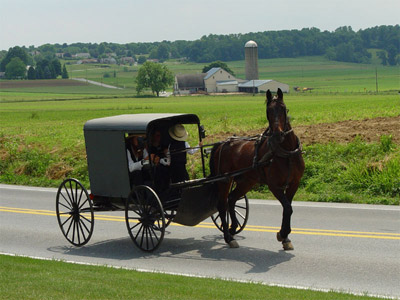
Amish family riding in a traditional Amish buggy
in Lancaster County, Pennsylvania, USA.
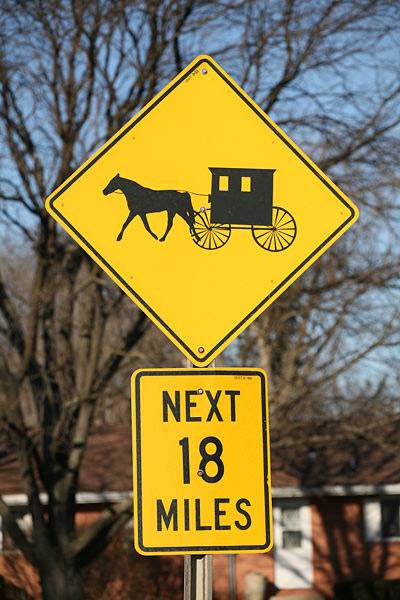
Signs erected in areas with Old Order Amish,
Old Order Mennonite or members of a few different Old
Order 'Brethren' groups, alerting motorists to the
presence of horse-drawn vehicles.
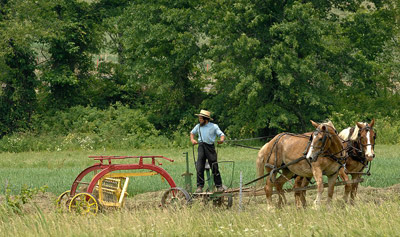
Amish man raking hay.
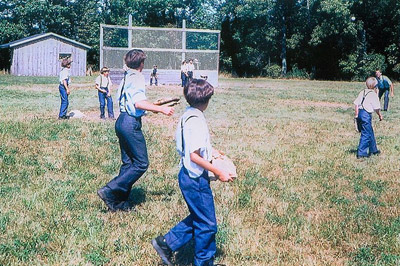
Amish children playing baseball.
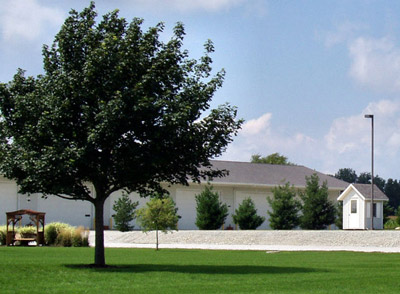
Telephone booth set up by an "English" farmer for
emergency use by local Amish families.
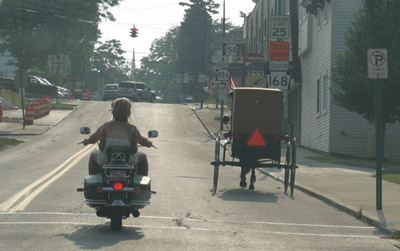
Modern and Amish transportation in
New Wilmington, Pennsylvania.
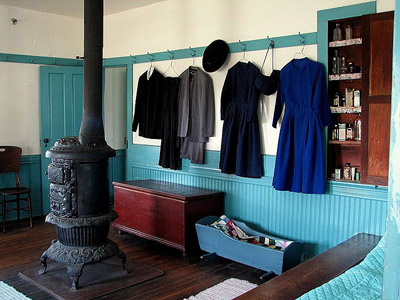
Amish household.
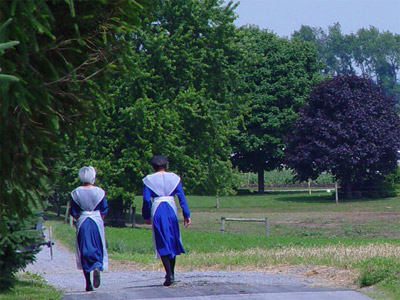
Amish girls in Lancaster County, Pennsylvania.
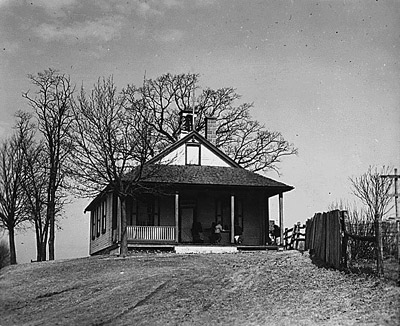
Amish schoolhouse in Lancaster County, Pennsylvania in
1941.
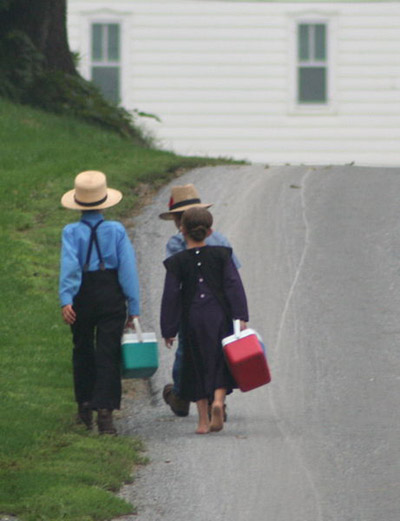
Amish school children. |